|
 War
and Anti-War Films often acknowledge the horror and heartbreak of
war, letting the actual combat fighting or conflict (against nations or humankind)
provide the primary plot or background for the action of the film. Typical
elements in the action-oriented war plots include POW camp experiences and
escapes, submarine warfare, espionage, personal heroism, "war is hell" brutalities,
air dogfights, tough trench/infantry experiences, or male-bonding buddy adventures
during wartime. Themes explored in war films include combat, survivor and
escape stories, tales of gallant sacrifice and struggle, studies of the futility
and inhumanity of battle, the effects of war on society, and intelligent and
profound explorations of the moral and human issues. War
and Anti-War Films often acknowledge the horror and heartbreak of
war, letting the actual combat fighting or conflict (against nations or humankind)
provide the primary plot or background for the action of the film. Typical
elements in the action-oriented war plots include POW camp experiences and
escapes, submarine warfare, espionage, personal heroism, "war is hell" brutalities,
air dogfights, tough trench/infantry experiences, or male-bonding buddy adventures
during wartime. Themes explored in war films include combat, survivor and
escape stories, tales of gallant sacrifice and struggle, studies of the futility
and inhumanity of battle, the effects of war on society, and intelligent and
profound explorations of the moral and human issues.
See Filmsite's comprehensive selection of the 100
Greatest War Films of All Time
See this site's selection of Greatest
War Films (in multiple parts)
Some
war films do balance the soul-searching, tragic consequences and inner
turmoil of combatants or characters with action-packed, dramatic spectacles,
enthusiastically illustrating the excitement and turmoil of warfare.
And some 'war' films concentrate on the homefront rather than on the
conflict at the military war-front. But many of them provide decisive
criticism of senseless warfare.
 War films have often been used as 'flag-waving' propaganda
to inspire national pride and morale, and to display the nobility of one's
own forces while harshly displaying and criticizing the villainy of the enemy,
especially during war or in post-war periods. Jingoistic-type war films usually
do not represent war realistically in their support of nationalistic interests,
while avoiding the reality of the horrors of war. The good guys are portrayed
as clashing against the bad guys (often with stereotyped labels such as 'krauts,'
'commies,' 'Huns,' or 'nips'). These revisionistic, politically-correct and
historically inaccurate films, in such diverse examples as Sands of Iwo
Jima (1949) and The Alamo (1960), would often redefine the
facts. War films have often been used as 'flag-waving' propaganda
to inspire national pride and morale, and to display the nobility of one's
own forces while harshly displaying and criticizing the villainy of the enemy,
especially during war or in post-war periods. Jingoistic-type war films usually
do not represent war realistically in their support of nationalistic interests,
while avoiding the reality of the horrors of war. The good guys are portrayed
as clashing against the bad guys (often with stereotyped labels such as 'krauts,'
'commies,' 'Huns,' or 'nips'). These revisionistic, politically-correct and
historically inaccurate films, in such diverse examples as Sands of Iwo
Jima (1949) and The Alamo (1960), would often redefine the
facts.
War films can also make political statements - unpopular wars
(such as the Vietnam War and the Iraq War), have generated both supportive
and critical films about the conflict (i.e., Robert Altman's M*A*S*H (1970),
Kenneth Branagh's Henry V (1989), and Michael Moore's documentary Fahrenheit
9/11 (2004)).
War films are often paired with other genres, such as romance, comedy (black), and suspense-thrillers.
A number of war films are actually historical
epics, authentic attempts to recreate the experience of war on screen,
rather than pure war films. Some are actually westerns masquerading as war films.
This genre has existed since the earliest years of cinematic
production in the silent era. Film-makers have been provided ample opportunities
for material from American history, stretching from the French and Indian
Wars to the Vietnam War. In particular, the many wars of the 20th century
(primarily the First and Second World Wars, but also subsequent wars) have
provided rich material for film makers. War films as a major film genre emerged
after the outbreak of World War I.
Earliest War Films:
The first war film to be documented was a one-reel, 90-second
propagandist effort - the Vitagraph Company's fictitious Tearing Down the
Spanish Flag (1898), produced in the year of the Spanish-American War.
It portrayed a faked, reconstructed version of the seizure of a Spanish government
installation in Havana by U.S. Army troops, the removal of the foreign flag,
and its replacement by the Stars and Stripes.
One of the first to show the
necessity for preparedness during the Great War's European conflict, thereby
demonstrating the propagandistic power of the new medium, was Vitagraph's
silent film drama The Battle Cry of Peace (1915) with Norma Talmadge. It proposed the idea of what would happen if America was invaded on its own soil by a hostile European power and taken over, with an invasion of New York City. In 1918 in particular, many films documented the momentous sinking of the Lusitania in May of 1915 by a German U-boat and argued for US entrance into the war, such as Vitagraph's Over the Top (1918) (with its hero James Owen joining the British army after the Lusitania's sinking) and Winsor McKay's short animated film The Sinking of the Lusitania (1918).
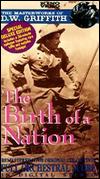 Early
filmmakers steered away from making war pictures because of their enormous
cost for extras - uniformed and equipped in massive battle sequences. Hollywood
producers did not recognize the box-office potential of propagandist war and
anti-war films until the success of D. W. Griffith's influential Civil War
epic adapted from Thomas Dixon's The Clansman, The Birth Of A Nation (1915), focusing on the effects of the war
on two families - the Southern Camerons and the Northern Stonemans. The film
included semi-documentary, panoramic battle scenes and other historical events
during the Civil War era. Early
filmmakers steered away from making war pictures because of their enormous
cost for extras - uniformed and equipped in massive battle sequences. Hollywood
producers did not recognize the box-office potential of propagandist war and
anti-war films until the success of D. W. Griffith's influential Civil War
epic adapted from Thomas Dixon's The Clansman, The Birth Of A Nation (1915), focusing on the effects of the war
on two families - the Southern Camerons and the Northern Stonemans. The film
included semi-documentary, panoramic battle scenes and other historical events
during the Civil War era.
A few major films argued for pacifism, such as producer Thomas Ince's preachy epic film Civilization (1916), in which the character of Christ himself toured the Emperor through the devastating results of war and preached a message of Love (not War). D. W. Griffith's 4-strand epic Intolerance (1916) was deliberately designed to show man's inhumanity to man and the horrors of war so that audiences would reject war. The film ended with divine intervention interrupting the conflict. One of the most popular hit songs of 1915 reflected the pacifistic mood: "I Didn't Raise My Boy to Be A Soldier," and President Wilson narrowly won a second term on a campaign promise to keep the US out of the European conflict.
[Although American Civil War war films are scarce, they include: Gone with the Wind (1939), the westerns Shenandoah (1965) and The Outlaw Josey Wales (1976), Glory (1989), Gettysburg (1993) and its prequel Gods and Generals (2003).]
World War I (The Great War) Era Films:
 However, the pacifist mood began to change and the eventual US entry into the war in April of 1917 provided Hollywood with one of
its greatest sources of plots - and profits. This was evidenced by the new hit song of the time, George M. Cohan's Over There (1917): "Johnny get your gun, get your gun, get your gun, Johnny, show the "Hun" you're a son-of-a-gun, Hoist the flag and let her fly, Yankee Doodle do or die." The propagandistic films served mostly as recruitment tools, and as
emotional tirades against the enemy, distastefully suggesting that heroic
American involvement would bring about victory, and serve as a crusade to 'make the world safe for democracy'. Americans were persuaded to buy 'liberty' war bonds, often by movie stars, to help finance the war. However, the pacifist mood began to change and the eventual US entry into the war in April of 1917 provided Hollywood with one of
its greatest sources of plots - and profits. This was evidenced by the new hit song of the time, George M. Cohan's Over There (1917): "Johnny get your gun, get your gun, get your gun, Johnny, show the "Hun" you're a son-of-a-gun, Hoist the flag and let her fly, Yankee Doodle do or die." The propagandistic films served mostly as recruitment tools, and as
emotional tirades against the enemy, distastefully suggesting that heroic
American involvement would bring about victory, and serve as a crusade to 'make the world safe for democracy'. Americans were persuaded to buy 'liberty' war bonds, often by movie stars, to help finance the war.
Hollywood director D. W. Griffith's Hearts of
the World (1918) was a sentimental, propagandistic film to encourage US
entry into the European conflict of the first world war - it included actual
battle footage filmed on location in 1917 on the outskirts of the war itself
(with the cooperation of the British War Office and the French Government).
Griffith's film expressed the effects of the war on a recruit, and displayed
the viciousness of the Germans in the person of actor/director Erich von Stroheim,
who played the part of a ruthless, cold-blooded, hateful officer - a "beastly
Hun." The semi-documentary My Four Years in Germany (1918), the first real hit for Warner Bros' Studios, was presented as fact - it presumed to show the first-hand experiences of James Gerard, the American ambassador to Germany from 1913-1917, including his witnessing of innumerable and cruel German "atrocities" that were greatly exaggerated in re-enactments, although they appeared true when mixed with actual footage.
After
the Armistice ending World War I in 1918, war films ceased for the most part. European film-making centers were in ruins, giving Hollywood the boost it needed. Hollywood was now responsible for 80% of US film production and New York controlled world film distribution. The anti-war film that made
Rudolf Valentino a star was Rex Ingram's very successful The Four Horsemen
of the Apocalypse (1921) - it used WWI as a backdrop for its story of
illicit love. Appearing around the same era to express the freedoms of
American democracy was Griffith's epic America (1924), a melodramatic
account of the American Revolution with innumerable set-pieces (the ride of
Paul Revere, Wintering at Valley Forge, etc.).
A Revival of War Films in the Mid-1920s:
 War films were revived in the
mid-1920s during peace-time. MGM's and King Vidor's The Big Parade (1925) was a new kind of war film, and the first
to realistically portray the horrors of battle and the struggle for survival
by three soldier-comrades (a bartender, a riveter, and a millionaire's son)
in the trenches. It also told of a love affair between an American doughboy
(John Gilbert) and a French peasant girl (Renee Adoree). The film was a spectacular success, and made more money than any other MGM film production up to its time. MGM wished to repeat the film's success with Tell It To the Marines (1926), with Lon Chaney as tough Marine sergeant, O'Hara (Chaney's own favorite role, a 'straight' one without makeup). Next to Garbo's Flesh and the Devil (1926), it was MGM's second most profitable film of the year. War films were revived in the
mid-1920s during peace-time. MGM's and King Vidor's The Big Parade (1925) was a new kind of war film, and the first
to realistically portray the horrors of battle and the struggle for survival
by three soldier-comrades (a bartender, a riveter, and a millionaire's son)
in the trenches. It also told of a love affair between an American doughboy
(John Gilbert) and a French peasant girl (Renee Adoree). The film was a spectacular success, and made more money than any other MGM film production up to its time. MGM wished to repeat the film's success with Tell It To the Marines (1926), with Lon Chaney as tough Marine sergeant, O'Hara (Chaney's own favorite role, a 'straight' one without makeup). Next to Garbo's Flesh and the Devil (1926), it was MGM's second most profitable film of the year.
Director Raoul Walsh's
pacifistic What Price Glory? (1926), Fox's answer to Vidor's film, was very different -- it
told of two Marines - Captain Flagg and Sgt. Quirt (Victor McLaglen and Edmund Lowe), who were fighting in WWI in France
against the enemy in authentic-looking trench warfare. It also showed the two comrades as rivals among
themselves vying for the affection of a French village girl named Charmaine
(Dolores Del Rio) - in many semi-comic scenes, they would obviously be swearing and using profanities toward each other (decipherable if one could read lips), but the title cards reflected more dignified talk: ("Thank you, Captain Flagg! Personally, I'd as soon find a skunk in my sleeping bag.") [John Ford remade the film in 1952 with James Cagney and
Dan Dailey.]
 Soon
after, director William Wellman's (and Paramount's) silent and early anti-war film Wings
(1927) appeared, the greatest of the early aviation epics with spectacular
dog-fight combat sequences, and a spectacular reconstruction of the Battle of St. Mihiel. It was the first film (and only silent film) to be
awarded Best Picture. It was the first film to introduce sound effects on a separate strip of film, and with dogfight scenes shot in the air (and not in the studio). Starring both "It" girl Clara Bow and Gary Cooper (in an early
role), it told the twisting romantic story of two aviators (Charles "Buddy"
Rogers and Richard Arlen) both in love with the same girl - Sylvia (Jobyna Ralston).
Both the first and third Best Picture winners were war films! Soon
after, director William Wellman's (and Paramount's) silent and early anti-war film Wings
(1927) appeared, the greatest of the early aviation epics with spectacular
dog-fight combat sequences, and a spectacular reconstruction of the Battle of St. Mihiel. It was the first film (and only silent film) to be
awarded Best Picture. It was the first film to introduce sound effects on a separate strip of film, and with dogfight scenes shot in the air (and not in the studio). Starring both "It" girl Clara Bow and Gary Cooper (in an early
role), it told the twisting romantic story of two aviators (Charles "Buddy"
Rogers and Richard Arlen) both in love with the same girl - Sylvia (Jobyna Ralston).
Both the first and third Best Picture winners were war films!
War Films at the Start of the Talkies:
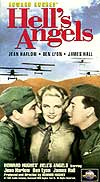 War films were suddenly big business again, after the success of war genre films in the mid-20s caused a revival, such as The Patent Leather Kid (1927) (with Best Actor-nominated Richard Barthelmess) and the early talkie She Goes to War (1929) with Eleanor Boardman. The
start of the talkie era meant that war films would now be supplemented with
the realistic sounds of war - aerial dogfights, explosions, gunfire, etc.
Millionaire director/producer Howard Hughes' expensive Hell's
Angels (1930) featured more impressive WWI aerial battle sequences
- and the debut of platinum blonde sex symbol Jean Harlow (speaking the famous
saucy line: "Would you be shocked if I put on something more comfortable?")
in love with two English brothers who were British Royal Flying Corps pilots
(Ben Lyon and James Hall). War films were suddenly big business again, after the success of war genre films in the mid-20s caused a revival, such as The Patent Leather Kid (1927) (with Best Actor-nominated Richard Barthelmess) and the early talkie She Goes to War (1929) with Eleanor Boardman. The
start of the talkie era meant that war films would now be supplemented with
the realistic sounds of war - aerial dogfights, explosions, gunfire, etc.
Millionaire director/producer Howard Hughes' expensive Hell's
Angels (1930) featured more impressive WWI aerial battle sequences
- and the debut of platinum blonde sex symbol Jean Harlow (speaking the famous
saucy line: "Would you be shocked if I put on something more comfortable?")
in love with two English brothers who were British Royal Flying Corps pilots
(Ben Lyon and James Hall).
One of the earliest anti-war films to effectively denounce
the horrors of war was director Lewis Milestone's stirring, impassionate All Quiet on the Western Front (1930), made in both silent and sound versions. Possibly the greatest anti-war
film ever made, it was based upon the novel by Erich Maria Remarque that viewed
the Great War from the German point of view. All of the young idealistic German youths
who have gone to the front to voluntarily serve the Fatherland become disillusioned
and end up victims of the struggle. It portrayed soldiers as human
beings who were ravaged by their experiences. The film ended simplistically on the day of Armistice -- young soldier Paul's (Lew Ayres) death to the sound of the whine of a French sniper's bullet as
his hand reached out to touch a beautiful butterfly from the shell-hole
trench. The film's final images were composed of ghostly soldiers marching away, while superimposed over a dark, battle-scarred
hillside covered with a sea of white crosses.
A similar, accurate account
of the war was German film-maker/director G. W. Pabst's first talkie Westfront
1918 (1930) (aka Comrades of 1918), an anti-war film about the
futility of trench warfare for German and French soldiers on the Western Front
in WWI. Howard Hawks' melodramatic anti-war film The Road to Glory (1936) portrayed the futility of WWI trench warfare of the French, starring Fredric
March and Warner Baxter as officers of a weary regiment of French soldiers.
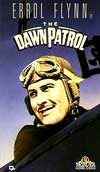 Because
WWI was a decidedly difficult subject to look back upon, movie-goers preferred
to see exciting action/adventure war films rather than condemnations of war,
such as The Dawn Patrol (1930), starring Douglas Fairbanks, Jr. and
Richard Barthelmess as pilots, which told the stirring, more glamorous
story of the British Royal Flying Corps at a remote outpost in France during
World War I. [The film was remade eight years later, director Edmund Goulding's The Dawn Patrol (1938), with Errol Flynn in the lead role as a flight
commander and Basil Rathbone as the commander officer forced to send amateur
pilots into the air against ace German fliers. Flynn also starred in director
Michael Curtiz' historically-inaccurate The Charge of the Light Brigade
(1936), about the memorable military engagement during the mid-19th century
Crimean War, that also included a romantic pairing with 19 year old Olivia
de Havilland.] Director Frank Borzage's A Farewell to Arms (1932),
adapted from Ernest Hemingway's novel, told a tale of WWI romance between
a wounded American officer (Gary Cooper) in the Italian ambulance corps and
an English Red Cross nurse (Helen Hayes). Because
WWI was a decidedly difficult subject to look back upon, movie-goers preferred
to see exciting action/adventure war films rather than condemnations of war,
such as The Dawn Patrol (1930), starring Douglas Fairbanks, Jr. and
Richard Barthelmess as pilots, which told the stirring, more glamorous
story of the British Royal Flying Corps at a remote outpost in France during
World War I. [The film was remade eight years later, director Edmund Goulding's The Dawn Patrol (1938), with Errol Flynn in the lead role as a flight
commander and Basil Rathbone as the commander officer forced to send amateur
pilots into the air against ace German fliers. Flynn also starred in director
Michael Curtiz' historically-inaccurate The Charge of the Light Brigade
(1936), about the memorable military engagement during the mid-19th century
Crimean War, that also included a romantic pairing with 19 year old Olivia
de Havilland.] Director Frank Borzage's A Farewell to Arms (1932),
adapted from Ernest Hemingway's novel, told a tale of WWI romance between
a wounded American officer (Gary Cooper) in the Italian ambulance corps and
an English Red Cross nurse (Helen Hayes).
Pre-WWII War Films:
 For
most of the decade of the 1930s, war films went into decline due to
increasing US isolationism, and Hollywood made fewer and fewer of
them. Then, in the late 1930s, French filmmaker Jean Renoir attempted
to signal a warning about warfare's 'grand illusions' with the classic
anti-war film La Grande Illusion
(1937, Fr.), set in a WWI German prison camp in 1916 where an aristocratic
French officer faced a dilemma regarding his escape with other POWs.
Likewise, Renoir's comedy/farce The Rules of the Game (1939) was
an indictment of decadent, morally-bankrupt, self-indulgent French
upper-class aristocrats. For
most of the decade of the 1930s, war films went into decline due to
increasing US isolationism, and Hollywood made fewer and fewer of
them. Then, in the late 1930s, French filmmaker Jean Renoir attempted
to signal a warning about warfare's 'grand illusions' with the classic
anti-war film La Grande Illusion
(1937, Fr.), set in a WWI German prison camp in 1916 where an aristocratic
French officer faced a dilemma regarding his escape with other POWs.
Likewise, Renoir's comedy/farce The Rules of the Game (1939) was
an indictment of decadent, morally-bankrupt, self-indulgent French
upper-class aristocrats.
When the war in Europe commenced in 1939, British film directors
tried to alert Americans about the looming German and Italian Fascist threat.
Alfred Hitchcock's political/war-time thriller Foreign
Correspondent (1940), his second American film, concluded with a plea
to the American public to enter the war ("It's as if the lights were
all out everywhere, except in America. Keep those lights burning there! Cover
them with steel! Ring them with guns! Build a canopy of battleships and bombing
planes around them! Hello, America! Hang on to your lights. They're the only
lights left in the world..")
 Charlie
Chaplin lampooned Adolf Hitler (in the role of Adenoid Hynkel) and The Third
Reich in The Great Dictator (1940), the director/actor's first all-talking
picture - it was Chaplin's last film with the Little Tramp character. Hitler
banned German audiences from viewing the picture due to its offensive characterization
and even some American audiences believed that Chaplin had become self-indulgent.
In the late 30s and early 40s, Hollywood began to increase its own number
of war-related films, such as director Anatole Litvak's bold Confessions
of a Nazi Spy (1939) with Edward G. Robinson and Paul Lukas, about a Nazi
espionage/spy ring operating in the US. The beautiful romantic tragedy and
tearjerker Waterloo Bridge (1940) told the tale of a ballerina (Vivien
Leigh) whose love affair with a British officer (Robert Taylor) was shattered
by the events of World War II. For Whom the Bell Tolls (1943), based
on the novel by Ernest Hemingway, told the story of Robert Jordan (Gary Cooper),
an American demolition expert who gave his abilities to the Anti-Fascist freedom
fighters of Spain in the 1930s. Charlie
Chaplin lampooned Adolf Hitler (in the role of Adenoid Hynkel) and The Third
Reich in The Great Dictator (1940), the director/actor's first all-talking
picture - it was Chaplin's last film with the Little Tramp character. Hitler
banned German audiences from viewing the picture due to its offensive characterization
and even some American audiences believed that Chaplin had become self-indulgent.
In the late 30s and early 40s, Hollywood began to increase its own number
of war-related films, such as director Anatole Litvak's bold Confessions
of a Nazi Spy (1939) with Edward G. Robinson and Paul Lukas, about a Nazi
espionage/spy ring operating in the US. The beautiful romantic tragedy and
tearjerker Waterloo Bridge (1940) told the tale of a ballerina (Vivien
Leigh) whose love affair with a British officer (Robert Taylor) was shattered
by the events of World War II. For Whom the Bell Tolls (1943), based
on the novel by Ernest Hemingway, told the story of Robert Jordan (Gary Cooper),
an American demolition expert who gave his abilities to the Anti-Fascist freedom
fighters of Spain in the 1930s.
A realistic portrayal of the demands of career military life
just before US involvement in WWII was examined in Fred Zinnemann's multi-awarded,
Best Picture-winning From Here to Eternity (1953),
based on James Jones' novel. It starred Burt Lancaster as a tough sergeant,
Montgomery Clift as a bugler/private, Deborah Kerr as a commander's unfulfilled
wife, and Donna Reed as a local prostitute.
 During
the war years before the American entrance into the conflict, many Hollywood
films were action-adventure features, with caricatures of fearsome Germans
and Japanese and clean-living, all-American soldiers. One of the most effective
films to promote heroic US patriotism was Sergeant York (1941) starring
Gary Cooper (who won a Best Actor Academy Award for his role as a real-life,
backwoods, conscientious-objecting Tennessee farmer). The film was a biography
of the most decorated and famous American hero of World War I during the Battle
of Argonne - pacifist Sergeant Alvin C. York. And in the flag-waving The
Fighting 69th (1940), James Cagney starred as one member of a famed Irish-American
regiment in the Rainbow Division's 165th Infantry of New York, that fought
during WWI. During
the war years before the American entrance into the conflict, many Hollywood
films were action-adventure features, with caricatures of fearsome Germans
and Japanese and clean-living, all-American soldiers. One of the most effective
films to promote heroic US patriotism was Sergeant York (1941) starring
Gary Cooper (who won a Best Actor Academy Award for his role as a real-life,
backwoods, conscientious-objecting Tennessee farmer). The film was a biography
of the most decorated and famous American hero of World War I during the Battle
of Argonne - pacifist Sergeant Alvin C. York. And in the flag-waving The
Fighting 69th (1940), James Cagney starred as one member of a famed Irish-American
regiment in the Rainbow Division's 165th Infantry of New York, that fought
during WWI.
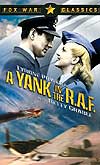 Now
on the brink of war in late 1941, director Henry King's romantic drama A
Yank in the R.A.F. (1941) was designed by producer Darryl F. Zanuck to
encourage support for American entry into WWII to aid Britain and France.
The film starred Tyrone Power as a brash, playboyish American pilot who enlisted
in the British RAF, fought in exciting air battles, and wooed London-based
showgirl/dancer and ex-girlfriend Betty Grable. Director Michael Curtiz' Dive
Bomber (1941) with exciting aerial footage was released by Warner Bros.
only a few months before the Pearl Harbor attack - it cast Errol Flynn as
a military aviator/doctor conducting experiments to prevent pilot-blackouts.
For lighter fare, audiences watched Abbott and Costello's breakthrough comedy Buck Privates (1941) with the famous pair accidentally enlisting in
the Army. Now
on the brink of war in late 1941, director Henry King's romantic drama A
Yank in the R.A.F. (1941) was designed by producer Darryl F. Zanuck to
encourage support for American entry into WWII to aid Britain and France.
The film starred Tyrone Power as a brash, playboyish American pilot who enlisted
in the British RAF, fought in exciting air battles, and wooed London-based
showgirl/dancer and ex-girlfriend Betty Grable. Director Michael Curtiz' Dive
Bomber (1941) with exciting aerial footage was released by Warner Bros.
only a few months before the Pearl Harbor attack - it cast Errol Flynn as
a military aviator/doctor conducting experiments to prevent pilot-blackouts.
For lighter fare, audiences watched Abbott and Costello's breakthrough comedy Buck Privates (1941) with the famous pair accidentally enlisting in
the Army.
British War Films After the US Entrance into WW II:
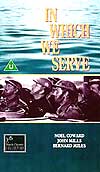 The
British cinema continued to produce many propagandist, flag-waving war films
glorifying their "finest hour" of battle against Germany and Japan, including
the inspiring In Which We Serve (1942). The story, about a valiant
crew of Lord Mountbatten's British destroyer (HMS Torrin) during the
Battle of Crete in WWII was told in a non-linear fashion with vignettes/flashbacks. The
British cinema continued to produce many propagandist, flag-waving war films
glorifying their "finest hour" of battle against Germany and Japan, including
the inspiring In Which We Serve (1942). The story, about a valiant
crew of Lord Mountbatten's British destroyer (HMS Torrin) during the
Battle of Crete in WWII was told in a non-linear fashion with vignettes/flashbacks. 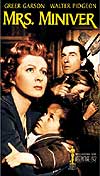 The film was the directorial debut of David Lean with Noel Coward as producer,
writer, co-director, and star. Director Carol Reed's semi-documentary Immortal
Batallion (1944) (aka The Way Ahead) followed the training of army
recruits by David Niven as they became a hardened combat team. The film was the directorial debut of David Lean with Noel Coward as producer,
writer, co-director, and star. Director Carol Reed's semi-documentary Immortal
Batallion (1944) (aka The Way Ahead) followed the training of army
recruits by David Niven as they became a hardened combat team.
A
British version of the homefront struggle illustrating UK resolve against
Nazi aggression was told in a sentimental story of an English middle-class
family during the early years of WW II (including the Dunkirk evacuation and
the blitz) in William Wyler's multi-award-winning Mrs. Miniver (1942),
the Best Picture of its year. The film ended with a memorable speech by the
Vicar (Henry Wilcoxon) preaching in a bombed out church: "This is the
people's war. It is our war. We are the fighters. Fight it, then. Fight it
with all that is in us, and may God defend the right." President FDR
had the speech printed and air-dropped over the war-torn European continent.
Another UK war/thriller, Went the Day Well? (1942) expressed characteristic
British reserve and strength among villagers who thwarted a take-over by Nazi
paratroopers posing as British soldiers. |
